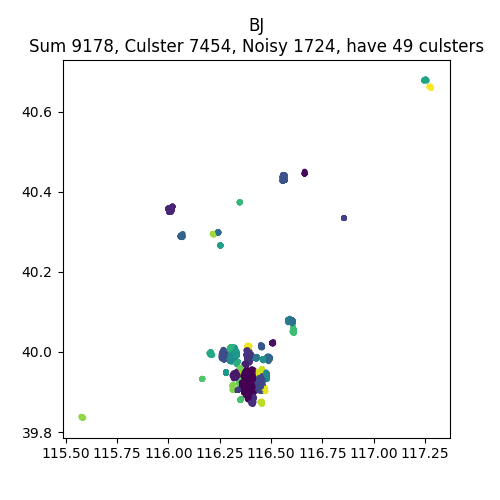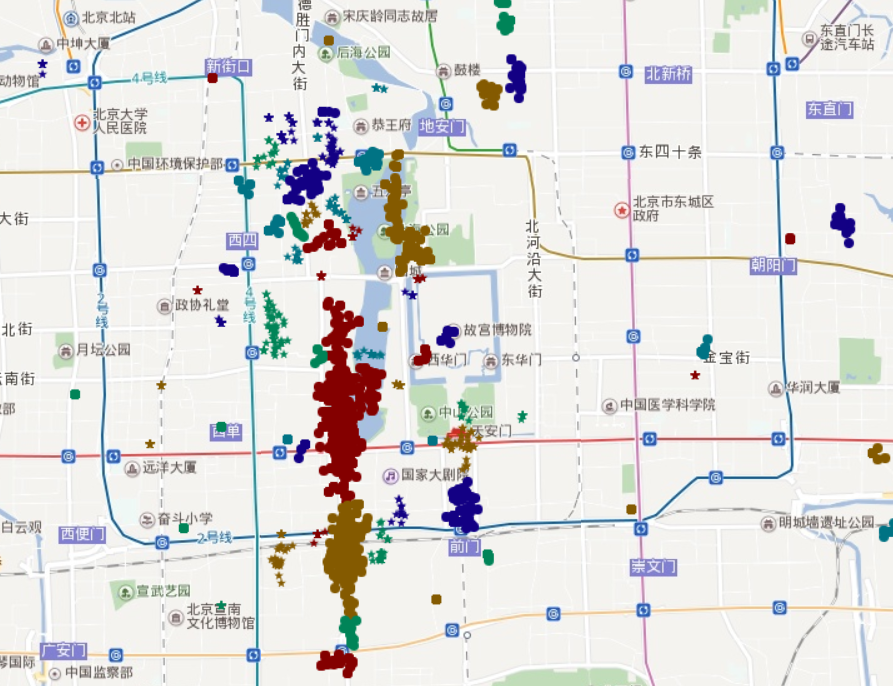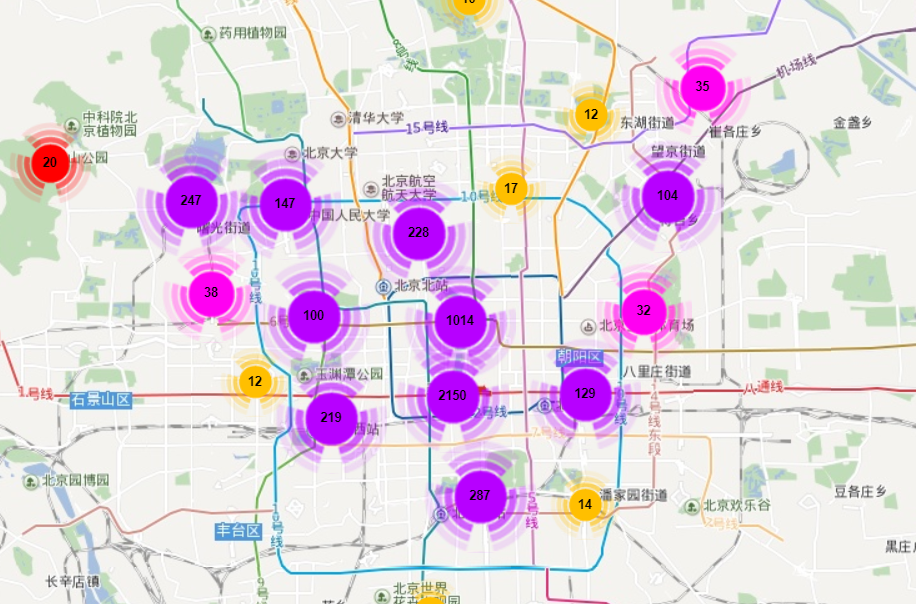使用百度地图api可视化聚类结果
1.写在前面
上接YFCC 100M数据集分析笔记,在对聚类出的照片GEO集聚类后,为了方便检测聚类结果,我们显示直接采用了 python 的 matplotlib 库以经纬度为坐标画出聚类结果,但发现这种方式对于聚类结果的显示并不是很直观,如下图,无法发现聚类结果和实际地形的关联:

于是想到使用百度地图的API,希望可以将聚类结果直接在实际的地图上投影,在参阅了百度地图官方API实例 之后,发现其提供的 海量点,点聚合 可以实现我们的需求。如下图。
海量点显示结果

点聚合显示结果

2.数据结构
在 data.js 文件中写入数据文件,分别表示[经度,维度,聚类id],如下:
var data = {"data":[
[116.391213,39.912766,0],
[116.391220,39.924350,0],
[116.391155,39.913297,0],
[116.390233,39.916517,0],
[116.390404,39.923420,0],
[116.390416,39.920463,0],
[116.390275,39.915332,0],
[116.391811,39.913633,0],
[116.392593,39.924877,0],
.....
[116.380920,39.835959,139],
[116.380920,39.835959,139],
[116.380920,39.835959,139],
[116.380920,39.835959,139],
],
"pointCount":5102,
"culsterCount":140}
3.实现代码
需要首先注册秘钥并将其添加到你的页面中。
<!DOCTYPE HTML>
<html>
<head>
<title>加载海量点</title>
<meta http-equiv="Content-Type" content="text/html; charset=utf-8"/>
<meta name="viewport" content="width=device-width, initial-scale=1.0, maximum-scale=1.0, minimum-scale=1.0, user-scalable=no">
<style type="text/css">
html,body{
margin:0;
width:100%;
height:100%;
background:#ffffff;
}
#map{
width:100%;
height:100%;
}
#panel {
position: absolute;
top:30px;
left:10px;
z-index: 999;
color: #fff;
}
#login{
position:absolute;
width:300px;
height:40px;
left:50%;
top:50%;
margin:-40px 0 0 -150px;
}
#login input[type=password]{
width:200px;
height:30px;
padding:3px;
line-height:30px;
border:1px solid #000;
}
#login input[type=submit]{
width:80px;
height:38px;
display:inline-block;
line-height:38px;
}
</style>
<script type="text/javascript" src="http://api.map.baidu.com/api?v=2.0&ak=秘钥"></script>
<script type="text/javascript" src="http://api.map.baidu.com/library/TextIconOverlay/1.2/src/TextIconOverlay_min.js"></script>
<script type="text/javascript" src="http://api.map.baidu.com/library/MarkerClusterer/1.2/src/MarkerClusterer_min.js"></script>
<script type="text/javascript" src="./data.js"></script>
</head>
<body>
<div id="map"></div>
<script type="text/javascript">
// 创建Map实例
var map = new BMap.Map("map", {});
// 初始化地图,设置中心点坐标和地图级别
map.centerAndZoom(new BMap.Point(105.000, 38.000), 5);
//启用滚轮放大缩小
map.enableScrollWheelZoom();
// 设置不显示高速路网
map.setMapStyle({
styleJson: [{
"featureType": "highway",
"elementType": "all",
"stylers": {
"visibility": "off"
}
}]
});
var culsters = loadDate();
// 二选一,绘制海量点或点聚合
piontCluster(culsters);
//massivePoint(culsters);
//点聚合实现代码
function piontCluster(culsters) {
var markers = [];
for(var i=0; i<culsters.length; i++){
for(var j=0; j<culsters[i].length; j++){
markers.push(new BMap.Marker(culsters[i][j]));
}
}
//最简单的用法,生成一个marker数组,然后调用markerClusterer类即可。
var markerClusterer = new BMapLib.MarkerClusterer(map, {markers:markers});
}
//海量点显示代码
function massivePoint(culsters) {
// 判断当前浏览器是否支持绘制海量点
if (document.createElement('canvas').getContext) {
// 设置颜色数组
var colors = ['#840000', '#008458', '#130084', '#845a00','#007384'];
// 设置形状数组
var shapes = [BMAP_POINT_SHAPE_CIRCLE, BMAP_POINT_SHAPE_STAR];
for(var i=0; i<culsters.length; i++){
var options = {
size: BMAP_POINT_SIZE_SMALL,
shape: shapes[i % shapes.length],
color: colors[i % colors.length],
}
var pointCollection = new BMap.PointCollection(culsters[i], options);
map.addOverlay(pointCollection);
}
//最简单的用法,生成一个marker数组,然后调用markerClusterer类即可。
var markerClusterer = new BMapLib.MarkerClusterer(map, {markers:markers});
}
else {
alert('请在chrome、safari、IE8+以上浏览器查看本示例');
}
}
// 从data.js中加载数据
function loadDate() {
var curPoint = 0;
var curCulster = 0;
// 二维数组,保存所有聚类的点的信息
var culsters = [];
// 遍历每个聚类,将同个聚类的点至于points
var points = [];
while (curPoint < data.pointCount) {
if(curCulster == data.data[curPoint][2]) {
points.push(new BMap.Point(data.data[curPoint][0], data.data[curPoint][1]));
curPoint = curPoint + 1;
}
else{
culsters.push(points);
points = [];
curCulster = curCulster + 1;
}
}
culsters.push(points);
points = [];
curCulster = curCulster + 1;
return culsters;
}
</script>
</body>
</html>
4.存在的问题
由于在 海量点 中对每个聚类做了特殊处理,使其在展示的时候能显示不同的颜色和形状,所以多次进行了 addOverlay ,会导致加载点太多时的卡顿现象。

